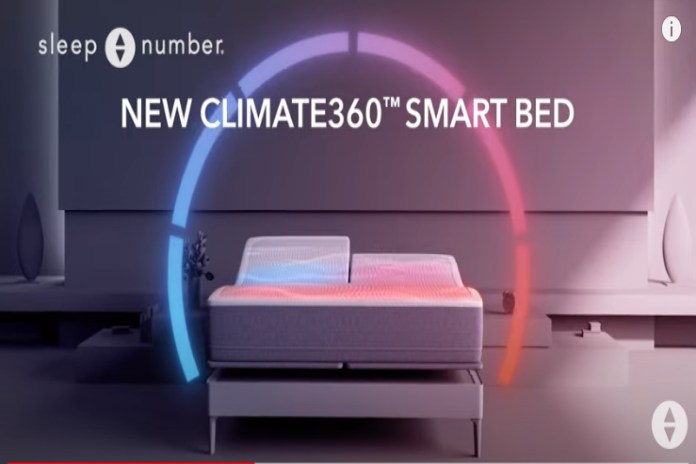It may seem absurd to spend hundreds of dollars on a mattress primarily made of air due to its low volume. But everything is possible with some marketing wizardry and a few alluring extras, real or made-up. The most popular brand of adjustable air beds, Sleep Number, provides 11 types with different levels of cushioning that can all be inflated to the required hardness with the push of a button. Sleep Number is an expensive alternative if you sleep alone and have a constant firmness preference. However, those movable, air-filled chambers can be worthwhile for couples with diverse preferences for mattress firmness.
Understanding Sleep Number
The Sleep Number 360 Smart Bed line and the Sleep Number Value Bed line are the two mattress brands that Sleep Number offers.
There are four series in the Sleep Number 360 Smart Bed line, most of which include multiple models:
-
-
- Classic Show (c2 and c4)
- Performance Collection (p5, p6, and pSE)
- Innovation Series (i8, i10, and iLE)
- Cooling Memory Foam (m7)
-
The Sleep Number 360 Smart Beds and Value Beds are equivalent to any other mattresses in terms of design: Each has a lower “support” portion and an upper “comfort” portion constructed of foam layers. In contrast to traditional mattresses with lower support sections made of foam or springs, Sleep Number mattresses have a movable air chamber and, except for the Classic Series and Value lines, a “support” pad. Couples can independently customize the hardness levels in these air chambers to their preferences. In the bed, there is also a sleep tracker.
The essential elements function as follows:
By adding or subtracting air to the air chamber, you can modify the hardness of the mattress—your “sleep settings.” The settings can be changed in increments of 5 (so there are 20 settings) via the SleepIQ app on your phone or tablet or with a remote (an extra $40). The settings range from 5 (most minor firm) to 100 (most firm). The tissue-box-sized pump for the 360 Smart Beds is built onto a base ($300 for a queen), which goes with the mattress. The pump will rest on the floor if you don’t buy the base. Even with the $300 purchase of its matching base, the pump for Value Beds is expressly made to sit on the floor.
Sleep Number mattresses, except the twin and full sizes, have independent air chambers on each side, allowing you and your spouse to select your preferred firmness levels. According to the manufacturer, the Responsive Air technology used in the 360 Smart Bed series enables these air chambers to adjust automatically when you change positions during the night. For example, if you roll onto your side, the bed will release air to provide more excellent give. The tweaks were so minor and sparse when I tested this feature at home that I hardly noticed a difference. I didn’t mind the quiet buzzing sound the bed makes with each unintentional (and intentional) adjustment, but if you’re a light sleeper, it might wake you.
A layer of foam padding additionally surrounds the air chamber. The price of the mattress also increases with the thickness of the foam portion on top. We are dissatisfied that Sleep Number merely refers to the foam it utilizes as “proprietary foam” and does not specify the type or density. (We believe you should disclose your product’s contents to clients paying thousands of dollars for it.) However, the foam in Sleep Number mattresses is likely a non-memory polyurethane foam, except the memory foam in the Cooling Memory Foam (m7) bed, which makes memory foam its selling point (also known as polyfoam). Polyfoam is a common component of mattresses. The Sleep Number foam has the same non-silky feel as the Tuft & Needle, which we evaluated for our foam mattress guide. Except for the Cooling Memory Foam (m7) bed, the Sleep Number mattresses are cushiony but not especially contoured or excessively fluffy. The Performance (p) line is in the middle, with the Innovation I line having the most excellent cushion and the Performance (c) and Value (s) lines having the least.
The mattress contains the sleep-tracking sensors used by Sleep Number. Ballistocardiography, a procedure that measures the force produced as the heart pumps blood into its surrounding central veins, is how the company’s SleepIQ technology detects heart and breathing rates and body movements. After being uploaded to the cloud, this data is processed by an algorithm to provide a sleep report highlighting restless and peaceful sleep times. Your SleepIQ app automatically populates this report with advice on how to sleep better. The benefit of the sleep-tracking sensor is that as soon as you fall asleep, it begins tracking your movements (no need to set it up every night, as you would with a sleep-tracking app on your phone). The drawback is that as soon as you flop onto the bed, the sensor begins monitoring your motions, so long naps and in-bed reading sessions are recorded as sleep (though if you have a two-hour gap in between, it will show up as separate sessions).
Additionally, I was a little surprised by the information that a customer care agent had access to when I spoke with her to get answers to our technical problems (“Looks like your spouse woke up about 5:30 a.m. yesterday…”). Fair enough, according to Sleep Number, nobody at the business can access the information unless you explicitly grant it. (Read more about that privacy statement here.) Additionally, the tracker has a “privacy mode” setting that prevents you from receiving recorded sleep data.
The truth is that you may examine your sleep in various ways, whether using an app on your phone or a fitness tracker (both with their own benefits and drawbacks). Even if SleepIQ is an intriguing addition, you shouldn’t let it influence your choice to purchase a Sleep Number mattress if you’re undecided.
What we believe about mattresses from Sleep Number
In general, you can spend much less on a more comfortable mattress. (For more information on our favorites, visit our guides to the best foam mattresses, hybrid mattresses, innerspring mattresses, and inexpensive mattresses.) However, suppose you have a flexible budget and insist on Sleep Number’s adjustability because you and your partner can’t agree on a firmness level. In that case, we believe only the Performance Series, Innovation Series, and Cooling Memory Foam mattresses are worthwhile options. The Value Bed and cheaper Classic Series mattress lines are too thin for most consumers. Spend the extra money on the beds in the Innovation Series if you prefer a comfortable mattress with adequate support because they feature thicker padding.
In addition to SleepIQ, Sleep Number’s marketing promotes technology that includes a foot-warming feature and says it will help you fall asleep more quickly. You could also stop your partner’s snoring by lifting the head of their side of the bed. But only the company’s adjustable bases—which are separately priced and range in price from $1,200 to $2,400 for a queen—offer these features. (We still have not tested them.)
Featured Image: Youtube © Sleep Number







